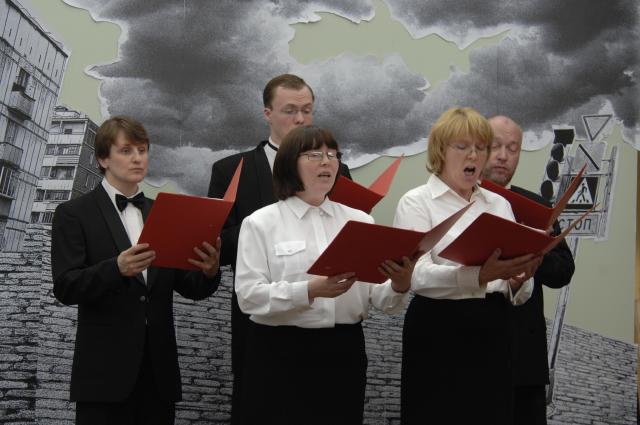CHTO Delat
Born early 2003 (founded) in St Petersburg . Lives and works in St Petersburg .

Chto Delat, Perestroika Songspiel, 2008 (video still), single-channel video, colour, sound, 28:30 mins. Realised by Olga Egorova (Tsaplya); Dmitry Vilensky; Natalia Pershina (Gliuklya); and Nikolai Oleinikov; music by Mikhail Krutik. Courtesy the artists
Chto Delat, which translates as ‘What is to be done’, is a redolent name. It refers to a Russian social novel by Nikolai Chernyshev written in 1864, as well as to an early political pamphlet by V.I. Lenin. This group was founded in Petersburg in 2003 by artists, philosophers, writers and critics from various regions in Russia with the goal of creating a collective whose primary aim was to merge political theory, art and activism, as well as to re-politicise Russian intellectual culture and reintegrate it with the greater international milieu of intellectual theory. Chto Delat is therefore a widespread social phenomenon, coordinated by the following members: Olga Egorova/Tsaplya (artist, Petersburg), Artiom Magun (philosopher, Petersburg), Nikolai Oleinikov (artist, Moscow), Natalia Pershina/ Glucklya (artist, Petersburg), Alexei Penzin (philosopher, Moscow), David Riff (art critic, Moscow), Alexander Skidan (poet, critic, Petersburg), Kirill Shuvalov (artist, Petersburg), Oxana Timofeeva (philosopher, Moscow) and Dmitry Vilensky (artist, Petersburg).
The organisation of the group is centred on the idea of ‘art soviets’, inspired by the workers’ councils that were formed in Russia around the time of the October 1917 Revolution. The primary focus of these ‘art soviets’ is as a model of participatory democracy for the politicisation of the processes of knowledge production. Chto Delat’s primary cultural output has been a bilingual (English/ Russian) newspaper that directs and publicises their ideas through the context of collective initiatives such as art projects, exhibitions, films and artistic interventions. The newspaper, which is handed out at congresses, conferences, exhibition openings and other events, is usually a direct documentary response to an artist’s project. The format of the paper consists of theoretical essays, questionnaires, interviews and comic strips. The projects that inspire it usually relate to the exploration and actualisation of poststructural and critical theory within the context of post-perestroika Russia and Eastern Europe. For the 17th Biennale of Sydney, Chto Delat will be presenting a film entitled Perestroika Songspiel (2008). The script for the film is based on documents and eyewitness accounts of the perestroika period in Soviet history. The film unfolds on 21 August 1991, after the victory over the restorationist coup. This day in Russian history was of national significance in that the country felt immense pride and hope regarding the arrival of democracy in Russia. The film focuses on five central protagonists, each representing a particular section of Russian politics and ideology: a revolutionary, a nationalist, a businessman, a feminist and a democrat. The chorus that performs the songs analyses each protagonist’s role in what has unfolded.
Chto Delat ironically parallels the format of the film with that of an ancient tragedy, referring also to the theatrical conventions of Bertolt Brecht. The appropriation of this format draws in the idea of the political morality play, the chorus representing public consensus over a particular issue. They offer a sense of rich spectacle to the drama, giving commentary and underlining the main themes animating the action. The chorus, the artists suggest, is the incarnation of public opinion – the people. The film analyses the specific vectors and social forces that played out in that particular historical moment, while the resulting political critique directly addresses the naiveties and difficulties that have faced Russian society in the process of realising its postcommunist future.
Chto Delat subsequently made a film on nationalism in the Balkans during the 1990s and its relationship to the post-Soviet situation. In 2010, this was followed by a new songspiel that reflects on the changed realities of Russia under President Vladimir Putin.
Selected Group Exhibitions
2010 ‘re: ex-post. Critical Knowledge and the Post-Yugoslavian Condition’, Open Space, Vienna, Austria
2009 ‘What Keeps Mankind Alive’, 11th International Istanbul Biennale, Turkey
2009 ‘Where Everything is Yet to Happen’, SpaPort Biennial 2009/2010, Banja Luka, Bosnia-Herzegovina
2009 ‘PRAXIS: Art in Times of Uncertainty’, Thessaloniki Biennale:2, Thessaloniki, Greece
2009 ‘No More Reality, Crowd and Performance’, DEPO, Istanbul, Turkey
Selected Bibliography
David Riff and Dmitry Vilensky, ‘From Communism to Commons?’, Third Text, vol. 23, issue 4 July 2009, pp. 465–80
Dmitry Vilensky and Gerard Raunig, ‘An Issue of Organisation: Chto Delat?’, Afterall, no. 19, autumn–winter 2008: www.afterall.org/journal/issue.19/issue.organisation.chto.delat
Nicholas Herman, ‘David Riff, What is to be done?’, Russian Art in Translation, Ante Projects, 2007
David Riff and Dmitry Vilensky (eds.), ‘What does it mean to Lose? The Experience of Perestroika’, Chto Delat / What is to be done?, newspaper of the platform Chto Delat, no. 19, September 2008, Moscow: www.chtodelat.org
David Riff and Dmitry Vilensky (eds.), ‘What do we have in common?’, Chto Delat / What is to be done?, newspaper of the platform Chto Delat, no. 9, May 2005, Moscow: www.chtodelat.org




























